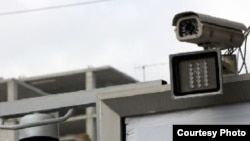Road policing and safety in Armenia has improved further this year thanks to the growing use of surveillance cameras by the traffic police, a pressure group defending drivers’ rights said on Friday.
“By and large, there is now law and order,” said Eduard Hovannisian, chairman of the Achilles non-governmental organization. “That law and order can be enhanced. But you can see that work is being done in that direction.”
The first cameras designed to detect and punish traffic violations were installed on key streets and road intersections in Yerevan last January as part of a gradual introduction of a centralized road surveillance system. The Armenian government plans to have some 280 digital devices installed across the country by 2017. It says they will make road policing more objective and efficient and complicate police corruption.
Until this year the Armenian traffic police used only mobile radars and digital cameras placed in cars patrolling streets and highways. Officers are required to turn them on while on duty.
According to Hovannisian, traffic has become more orderly since January. The Achilles chief said video policing has already made Armenian motorists “more disciplined and attentive” and reduced arbitrary practices among police officers patrolling streets. In particular, he said, the latter are now doing a much better job of properly documenting traffic violations with tickets handed to delinquent drivers on the spot or sent to them by mail.
“Whereas in the past there was virtually no [punitive] decision in which we couldn’t find any violations, now it’s all the way around,” Hovannisian told RFE/RL’s Armenian service (Azatutyun.am).
Achilles has a more than decade-long history of drivers’ rights advocacy, having lobbied for police reform, campaigned against corruption and helped hundreds of car owners to file lawsuits against the traffic police.
The installation of cameras is part of a broader five-year plan to make Armenian roads safer that was launched by the government in 2009. The plan’s implementation began with a significant toughening of traffic fines and a crackdown on the widespread and long-standing non-use of safety belts.
Some of those fines will become even heftier with the entry into force on June 2 of amendments to Armenia’s Code of Administrative Offense approved by the parliament earlier this year.
Hovannisian criticized the measure, saying that the existing financial penalties are already strict enough. “Nothing will change. There will just be more complaints and lawsuits,” he said, adding that the police are mainly concerned with collecting additional revenue partly used for rewarding police officers.
Norik Sargsian, a senior police official, denied that. “Our job is not to raise our extra-budgetary funds but to ensure road safety,” he told RFE/RL’s Armenian service.
“By and large, there is now law and order,” said Eduard Hovannisian, chairman of the Achilles non-governmental organization. “That law and order can be enhanced. But you can see that work is being done in that direction.”
The first cameras designed to detect and punish traffic violations were installed on key streets and road intersections in Yerevan last January as part of a gradual introduction of a centralized road surveillance system. The Armenian government plans to have some 280 digital devices installed across the country by 2017. It says they will make road policing more objective and efficient and complicate police corruption.
Until this year the Armenian traffic police used only mobile radars and digital cameras placed in cars patrolling streets and highways. Officers are required to turn them on while on duty.
According to Hovannisian, traffic has become more orderly since January. The Achilles chief said video policing has already made Armenian motorists “more disciplined and attentive” and reduced arbitrary practices among police officers patrolling streets. In particular, he said, the latter are now doing a much better job of properly documenting traffic violations with tickets handed to delinquent drivers on the spot or sent to them by mail.
“Whereas in the past there was virtually no [punitive] decision in which we couldn’t find any violations, now it’s all the way around,” Hovannisian told RFE/RL’s Armenian service (Azatutyun.am).
Achilles has a more than decade-long history of drivers’ rights advocacy, having lobbied for police reform, campaigned against corruption and helped hundreds of car owners to file lawsuits against the traffic police.
The installation of cameras is part of a broader five-year plan to make Armenian roads safer that was launched by the government in 2009. The plan’s implementation began with a significant toughening of traffic fines and a crackdown on the widespread and long-standing non-use of safety belts.
Some of those fines will become even heftier with the entry into force on June 2 of amendments to Armenia’s Code of Administrative Offense approved by the parliament earlier this year.
Hovannisian criticized the measure, saying that the existing financial penalties are already strict enough. “Nothing will change. There will just be more complaints and lawsuits,” he said, adding that the police are mainly concerned with collecting additional revenue partly used for rewarding police officers.
Norik Sargsian, a senior police official, denied that. “Our job is not to raise our extra-budgetary funds but to ensure road safety,” he told RFE/RL’s Armenian service.





